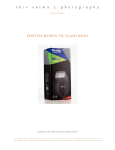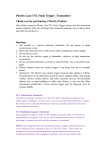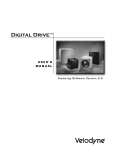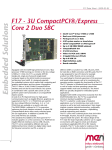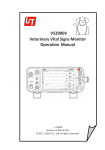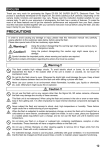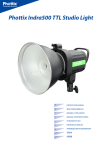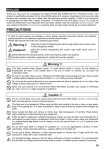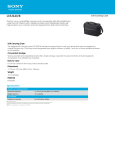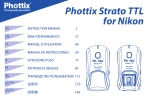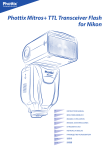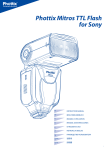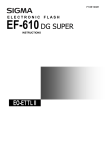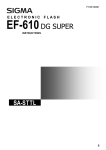Download Phottix Mitros TTL Flash for Canon Parts
Transcript
Phottix Mitros TTL Flash
for Canon
En
INSTRUCTION MANUAL
De
BENUTZERHANDBUCH
Fr
MANUEL D’UTILISATION
Es
MANUAL DE INSTRUCCIONES
Pl
INSTRUKCJA OBSŁUGI
It
ISTRUZIONI D’USO
Ru
РУКОВОДСТВО ПОЛЬЗОВАТЕЛЯ
Cn Simp
说明书
1
INSTRUCTION MANUAL
En
Phottix Mitros TTL Flash
for Canon
Note: To start immediately using this flash please refer to the quick-start guide.
For advanced features please read this manual and be familiar with your camera
manual and operations.
The Phottix Mitros TTL Flash for Canon is designed to work with Canon DSLR
cameras and features ETTL I/II, Manual, Multi modes as well as Wireless Master/
Slave triggering.
Warnings
1. Use your flash safely. Do not fire the flash into the eyes of people or animals at
short distances – damage and/or blindness can occur.
2. Be careful using the flash in or around cars, buses, motorcycles or other moving vehicles as accidents can result.
3. Never use the flash near combustible gases (gasoline, solvents, etc.).
Parts
Back / Left Side
1. LCD Display
2. Mode Button
3. Test Button
4. Power Switch
5. Ready Light
6. Arrow Adjustment
Buttons (see below)
7. Set Button
8. Locking Lever
9. 3.5mm Sync Port
10. USB Port
11. External Power Port
4. Do not expose the flash or batteries to dripping/splashing water, or high humidity.
5. Do not leave the flash or batteries in a hot location (direct sunlight, in a closed
car, etc.).
6. Remove batteries from the flash when not being used for an extended period
of time.
7. Change the batteries when required. Use undamaged batteries in good condition. Do not mix battery types or new and used batteries.
8. Do not put opaque objects in front of the flash lens when firing the flash. The
energy emitted by the flash may cause objects to burn, or cause damage to the
flash tube or fresnel lens.
9. Use caution in touching the flash head after use. It may be hot and can cause
burns.
Arrow Adjustment Buttons
1. Up Arrow / Zoom Adjustment Mode Button
2. Right Arrow / Wireless Flash Mode Button
3. Down Arrow / HSS / SCS Button
4. Left Button / Custom Functions Button
10. The flash contains high voltage electronic parts. Do not disassemble or attempt to repair the flash. Never touch the flash’s internal components.
11. Do not touch the External Power Port contacts with any metal objects – this
can cause electric shock and serious injury.
Table of Contents
Parts and Functions …...................................................…... 2
Modes …….............................................................................7
Wireless Triggering……........................................................ 9
Custom Functions…….........................................................11
Technical Specs…….............................................................12
2
Front / Right Side
1. Bounce Card
2. Wide Angle Diffuser
3. Flash Head
4. Wireless Signal Receiver Area
5. AF Assist Light
6. Hot Shoe
7. Battery Compartment
INSTRUCTION MANUAL
En
Please note:
These instruction assume:
1. Both the flash and camera are switched on.
2. The flash and camera are set to the same settings as this manual.
3. Camera menu and flash custom functions menu are set to default values.
4. The flash is being used with a compatible Canon DSLR.
Installing batteries
1. Press the battery cover in while pushing it towards the bottom of the flash.
The battery cover will open and raise.
2. Insert AA batteries as shown by the diagram inside the battery compartment.
3. Lower the battery cover and push back towards the top of the flash, locking
it in place.
Please note:
- Please use four standard high-quality batteries of the same brand. Make
sure all batteries are at similar powers levels.
- Batteries can get hot when the flash is being used. Use caution when changing batteries.
- If you do not use the flash for an extended period of time, store with batteries removed.
Attaching the flash to a camera
Turn off both the camera and flash
1. Align the flash hot shoe with the camera hot shoe.
Raising and Rotating the Flash Head
1. The flash head will elevate from -7 to 90 degrees with stops at -7, 0, 45, 60, 75
and 90 degrees. Gently raise or lower the flash head into the required position.
2. The flash head will rotate 180 degrees in either direction with stops at 60, 75,
90, 120, 150 and 180 degrees. Gently rotate the flash head into the required
position.
3. When the flash head is raised or rotated from the 0 degree standard forward
position the flash zoom will set itself to 50mm. “- -” will be displayed on the
LCD. Flash zoom when the head is raised or rotated can be changed in MZoom
mode (see below).
4. At -7 degrees the flash zoom will act the same as 0 degree – it will not change
any settings.
Using the Bounce Card or Wide Angle Diffuser
The Phottix Mitros Flash comes equipped with a white bounce card and wide
angle diffuser panel in the flash head.
1. The wide angle diffuser panel will cause the flash to spread light to a 14mm
equivalent.
2. The white bounce card can be used when the flash head is in a raised position
to bounce light forward to assist with catch lights in a subject’s eyes.
To use:
1. Gently pull the diffuser panel and bounce card from the flash head using
the ridge on the bottom of the diffuser panel.
2. If using the diffuser panel it will drop into position over the flash head. Gently push the bounce card back into the flash head if not needed.
3. If using the bounce card only gently push the diffuser panel back into the
flash head.
2. Slide the flash into the camera hot shoe until fully inserted.
3. Lock the flash in position by pushing the locking lever to the right until the
lock engages with a click.
4. To Unlock, press the locking release button on the locking lever and slide to
the left.
Turning the Flash On / Off
1. To power on the flash move the power switch to the on position.
2. To power off the flash move the power switch to the off position.
Battery Level Indicator
Using the Flash Head Diffuser
The Phottix Mitros TTL Flash comes with an attachable diffuser that can be added to the front of the flash head when needed. It is good for softening light,
reducing hot spots and shadows and better coverage for macro photography.
To use:
1. Align the diffuser with the flash head, with the “UP” mark on the diffuser
facing up.
2. Snap one side of the diffuser mount into the corresponding flash head
mount.
3. Repeat step 2 on the other side of the diffuser.
The Battery Level Indicator on the LCD (see below) will display an approximate
indication of how much power remains in the batteries in the flash. Use this as
a rough guide as to when a battery change is needed. If flash recycling time has
become very long (30 seconds) change the batteries.
3
Overheating Protection
The Phottix Mitros contains an overheating protection circuit that will slow flash
recycle time to avoid overheating-related damage. Approximately 20 full-power
flashes in a short amount of time will trigger this protection. A [ Hot! ] Icon will
appear when the overheating protection circuit is in operation.
To avoid further overheating or possible damage the flash will increase the recycling time to assist in lowering the flash temperature. Wait 10 minutes before
using the flash.
If the flash continues to be used after the [ Hot! ] Icon appears and the flash does
not cool down a [ Stop ] icon will appear on the LCD. Cease using the flash and
wait 10 minutes for it to cool down.
Sync and USB Ports
1. The 3.5mm Sync Port can be used with a 3.5mm sync cable to trigger the
flash – from a flash trigger or camera. This port is input only – flash signals are
not output from this port.
2. The USB port is used for firmware upgrades. Firmware announcements and
instructions will be made available on Phottix websites.
Status LED
Left LED: Flash-ready indicator. In Quick Flash Mode, the LED will flash green
when the flash has the minimum recycle charge. It will flash red when fully
charged.
Right LED: Flash exposure confirmation lamp. If a standard flash exposure is obtained, the flash exposure confirmation lamp will light blue for approximately 3
seconds. If the flash exposure confirmation lamp doesn’t light, move closer to
the subject or increase the camera ISO setting.
External Battery Port
The External Battery Port is a proprietary Phottix design for use with Phottix
flash cables. The external port is compatible with the Canon CP-E4 compact battery pack or compatible models when the included adapter is used.
Please note:
- Batteries must be used in the flash even when an external battery pack is
used.
- Never use non Canon-compatible battery packs.
4
The LCD Display
ETTL
M
Multi
M
Multi
14mm – 105mm
3.0EV (" C " will
be displayed on
Azoom
Mzoom
camera’ s EV
setting is
preferred.)
SCS
HSS
CH1 – 4
C.Fn
8:1 – 1:1 – 1:8
A
B
C
A:B:C
A+B+C
A : BC
A:B
SLAVE
MASTER
OFF
OS
FEB Information
(Shots taken / FEB amount)
Aperture
Flash range
(in meters/feet)
N(1 – 100)
1/1 – 1/128
(1 – 199) Hz
A B C
The LCD display on the Phottix Mitros flash contains important information regarding flash settings and functions.
In ETTL mode: HSS/SCS, FEB, EV
Top Line:
In Multi mode: Group, Power Level, Frequency, Flash Count
1. Flash Mode: Indicates the set mode of the flash - ETTL, Manual, Multi, M (slave
mode), Multi (slave mode)
Third Line:
2. Zoom: Indicates auto or manual flash head zoom and distance
3. Battery Level Indicator, Hot!, Stop
Second Line:
High Speed Sync (HSS) / Second Curtain Sync (SCS) icon
FEB, Group, Power Level, EV, Multi Mode indicators (Frequency and Flash Count)
In M mode: HSS/SCS, Group, Power Level
Beep Signal Icon, “-7°” icon, Master / Slave Triggering Area – displays channel,
master/slave mode, group information
Fourth Line:
Flash and Exposure information: C.Fn icon, Aperture (f stop), flash range and
flash ratio
5
Auto-Save Functions
The Phottix Mitros will remember flash settings. Mode, power levels, etc. will be
retained in the flash if it is turned off and then back on.
Setting Flash Zoom
The Phottix Mitros Flash has two flash head zoom modes – Auto (Azoom) and
Manual (Mzoom). Auto zoom will dynamically change flash head zoom as a
camera’s zoom lens is changed to provide optimum lighting. Manual zoom allow the user to set the zoom of the flash head.
To set:
1. Press the
button.
2. The Zoom area on the LCD will be highlighted and flash.
3. Press the
or
buttons to set the flash head zoom to Azoom
or the desired Mzoom manual level.
4. Press the
button when the zoom is properly set.
Please Note:
1. When in Azoom and the flash head is raised or rotated from the 0 degree
standard forward position - the flash zoom will set itself to 50mm. “- -” will be
displayed on the LCD. The flash zoom will not change if the head is lowered
to -7 degrees.
2. Azoom will work ONLY when the flash head is set to either 0 or -7 degrees.
3. When in Mzoom and the flash head is raised or rotated from the 0 degree
standard forward position - the flash zoom will not be changed from the previous setting.
4. Flash Zoom can be adjusted when the head is raised or rotated by switching to Mzoom mode and making desired adjustments.
Setting High Speed Sync or Second Curtain Sync
The Phottix Mitros flash has both High Speed Sync and Second Curtain Sync
functions. See further details under High Speed Sync and Second Curtain Sync later
in this manual.
To set:
1. Press the
2. The
button.
To save battery power the Phottix Mitros TTL Flash is equipped with Idle and
Auto Off modes.
1. In Non-Wireless Slave Modes: The flash will go into Auto Idle mode after 90
sec. if no buttons have been pressed or it has not been fired. The flash LCD will
go blank. Half-pressing the camera shutter button or pressing the test button
on the flash will wake up the Phottix Mitros.
2. In Wireless Slave Mode, the flash will go to Slave Idle Mode after 60 minutes if
no buttons have been pressed or it has not been fired, “IDLE” will be displayed
on the flash LCD. Full-pressing the camera shutter button or pressing the Master flash test button will wake up flashes in idle mode. Slave Idle Timer can be
changed from 60 minutes to 10 minutes (see C.Fn-10 below). The flash will go
into Slave Auto Off Mode after 8 hours if no buttons have been pressed or it has
not been fired after “IDLE” is displayed on the flash LCD. Pressing the test button
on the flash will wake it up. Slave Auto Off can be changed from after 8 hours to
after 1 hour (see C.Fn-11 below).
Modeling Flash
1. Pressing the camera depth-of-field preview button (if available) will fire the
flash continuously for 1 second. This Modeling Flash is useful in seeing lighting
effects and balance on the subject.
2. Modeling Flash is available in all modes, ETTL, Multi and Manual.
3. Modeling Flash can be used in both normal and wireless shooting and can be
set (see C.Fn-02 below).
Please note:
1. Overheating and damage can result from excessive use of the Modeling
Flash. Do not use more than 20 times in succession.
2. When overheating the flash will automatically increase charging time until
the flash temperature has decreased.
Autofocus (AF) Assist Light
1. In low light/contrast situations the Phottix Mitros’ built-in Auto Focus Assist
Light will illuminate to assist with AF. The AF Assist Light on the front of the flash
will project a focusing target on the subject.
2. AF Assist Light functions can be set to on or off (see C.Fn-08 below).
button will cycle between HSS, SCS and turning both off.
Please note:
-HSS and SCS are available in ETTL and Manual modes, but not in Multi mode.
Test Button
Pressing the test button will trigger the flash. This can be used for metering (in
manual mode only). In Wireless Master Mode pressing the test button will fire
slave flashes on the same channel being controlled by the Master flash. Test button output levels can be configured (see C.Fn-07 below).
6
Auto-Idle Functions
Adjustments
The Phottix Mitros will adjust levels in 1/3 stop increments. Some cameras have
custom functions to change stop adjustments from 1/3 to 1/2 stop increments
for FEB and FEC. If camera custom functions are changed the Phottix Mitros will
automatically adjust levels in 1/2 stops.
Flash Modes
Please note:
The Phottix Mitros has three flash modes: ETTL, Manual (M) and Multi (Stroboscopic).
- FEB shooting sequence can be changed (see C.Fn-04 below).
To change modes:
1. Press the
- By default: FEB will be cancelled after three photos are taken. FEB can be set
in the Custom Functions screen (see C.Fn-03 below).
- FEB can be used with FEC and FEL (see below).
button.
2. The flash modes will cycle through ETTL, Manual (M) and Multi modes.
3. The current mode will be displayed in the top left corner of the LCD.
ETTL Mode
- For best results set the camera drive mode to “single” and ensure the flash is
fully recharged before taking the second and third photos.
- Some cameras have custom functions to change stop adjustments from
1/3 to 1/2 stop increments for FEB and FEC. If camera custom functions are
changed the Phottix Mitros will adjust levels in 1/2 stop increments.
Flash Exposure Lock - FEL
Flash Exposure Lock (FEL) can be used to lock the flash exposure before a photo
is taken. This is useful when manual spot metering is being used in a scene with
different lighting conditions.
In ETTL Mode the flash and camera will work together to calculate the correct
exposure for recorded images. When the shutter button is fully pressed the flash
will fire a pre-flash that the camera will use to calculate exposure and flash power the instant before the photo is taken.
Flash Exposure Compensation - FEC
The Phottix Mitros Flash offers Flash Exposure Compensation (FEC) functions
and adjustements from -3 to +3 in 1/3rd stops. This is useful in situations where
fine-tuning of the TTL system is needed based on the environment.
To set FEC:
1. Press the
2. Press the
3. Press the
button to enter FEC Adjustment Mode.
or
buttons to adjust FEC up or down.
button to exit FEC Adjustment Mode.
Please note:
- Some cameras have custom functions to change stop adjustments from
1/3 to 1/2 stop increments for FEB and FEC. If camera custom functions are
changed the Phottix Mitros will adjust levels in 1/2 stop increments.
While in ETTL mode, press the camera’s FEL button (the “ ” button) to use this
function. See your camera user manual for more information on FEL functions
and usage.
Pressing the FEL Button will cause the flash to fire a pre-flash that will be used
to calculate flash power during the exposure. This will be retained in the camera
memory. The FEL icon will be displayed in the camera viewfinder.
Each time the FEL button is pressed a pre-flash will fire and a new exposure calculated. When the shutter button is fully pressed the flash will fire at the locked
exposure.
Please note:
- If the subject is too far away underexposure will result, the “FEL” icon will
blink for approximately 0.5 sec. in the camera viewfinder.
- If the subject is too small in the viewfinder, FEL may not be effective.
High Speed Sync – HSS
In HSS mode, the camera/flash maximum sync speed can reach the camera’s
maximum shutter speed. This is useful when using aperture priority mode or
to limit ambient light. HSS may vary with different camera models - see your
camera user manual for details.
Flash Exposure Bracketing - FEB
To use HSS mode:
Flash Exposure Bracketing (FEB) can be used to automatically change flash power over a series of photos. The camera will record three images with different
exposures – one exposed as per camera calculations, one over-exposed and
another under-exposed. Over and under exposure levels can be set by the user.
FEB is useful in run-and-gun situations as well as when shooting scenes with
different lighting conditions to help ensure a properly exposed photo. It can
also be used for HDR photography.
1. Press the
Some cameras have flash exposure storage function, see your camera user manual for more details.
1. Press the
To Set FEB:
button.
2. Press the
button. “FEB 0” will be displayed and highlighted on the LCD.
4. Press the
and
2. The HSS icon will be displayed on the flash LCD.
3. Set shutter speeds higher than the camera’s flash sync speed and take
photos.
To exit HSS mode:
button twice.
2. It will cycle from HSS to SCS and back to regular FCS mode.
Please note:
1. Press the
3. Press the
amount.
button.
- Check that the HSS icon is displayed in the viewfinder.
- HSS drastically reduces flash power, battery power and range.
buttons to adjust the exposure bracketing
button to confirm the setting.
7
Second Curtain Sync – SCS
The Phottix Mitros Second Curtain Sync function makes the flash fire at the end
of an exposure, not the beginning. This can be useful with slow shutter speeds
for capturing special effect.
5. Press the
button to exit the adjustment screen.
Please note:
1. Overheating and damage can result from excessive use of the Multi Stroboscopic Mode. Do not use more than 20 times in succession.
To use:
1. Press the
the SCS mode.
button twice. This will cycle from FCS to HSS and then
2. To cancel: Press the
mode.
button once. This will return to standard FCS
2. When overheated the flash will automatically increase charging time until
the flash temperature has decreased.
Stroboscopic Mode and Shutter Speeds
Please note:
To determine the proper camera shutter speed to be used with various Stroboscopic Mode variables, use the following formula:
SCS functions will not work in Wireless or Multi modes.
Number of flashes / Frequency = Shutter Speed
Example: 5x (number of flashes) / 10 Hz (Frequency) = .5 second shutter speed.
Manual (M) Mode
In Manual Mode the flash will fire at the power level you set. The Phottix Mitros
TTL Flash can be adjusted from 1/1 (full power) to 1/128 – 8 stops of adjustments
in 1/3rd stop increments. Aperture, shutter speed and ISO on the camera needs
to be manually adjusted. For best results use M-Manual mode on the camera.
This is a rough guideline: You may need to increase or decrease the shutter
speed to get the desired result.
Multi Stroboscopic Mode Output Chart
To use:
1. Press the
button until M is displayed on the flash LCD.
2. Press the
button to enter the power adjustment screen. The power
level will flash and be highlighted.
3. Press the
4. Press the
or
buttons to adjust the flash power.
button to exit the power adjustment screen.
5. When the flash ready light is illuminated red the flash is fully charged and
ready to fire.
6. Pressing the
button will fire the flash at the manual power level you
set. This is useful when taking meter readings.
Please note:
- Half pressing the shutter button will display the effective manual flash power range on the Flash LCD.
Multi: Stroboscopic Mode
With Multi Stroboscopic mode a series of rapid flashes will be fired. The flash
count, frequency and power of these flashes can be programmed on the Phottix
Mitros. Multi mode is useful for capturing multiple images of a moving subject
in the same photo and other special effects.
The frequency of the effect (in Hz. - number of flashes per second), the total
number of flashes and output levels can be set.
To use:
1. Press the
button until Multi is displayed on the flash LCD.
2. Press the
button to adjust Multi settings. Displayed (from left to right
on the LCD) Power, Frequency (HZ) and Flash Count. Power is highlighted and
flashing upon entering the adjustment screen.
3. Press the
and
(HZ) and Flash count.
buttons to change between Power, Frequency
4. Press the
and
buttons while the setting is highlighted to
adjust Power, Frequency (HZ) and Flash count to the desired levels.
8
If the number of flashes is displayed as “N---”, the maximum number of flashes
will be as shown by the table below regardless of the firing frequency.
Wireless Triggering Mode
The Phottix Mitros TTL Flash is equipped with wireless triggering. Using pulses
of light, a flash on the camera adjusts and fires remote flashes.
5. Select the transmission channel.
6. Select the Ratio mode (see below).
7. Press the
button to confirm and exit the screen.
The Phottix Mitros can also be triggered as an Optical Slave (OS). In OS mode
other nearby fired flashes will trigger the Mitros in manual mode only.
Master with Flash mode: The Master flash on the camera will fire when a
photo is taken.
A flash set in Master mode must be attached to the camera (or the camera popup flash used, if compatible). Remote flashes must be set to slave mode.
Master without Flash mode: The Master flash on the camera will not fire
when a photo is taken. The flash will emit a short burst of light to communicate with slave flashes but this light will not be part of the exposure.
Wireless triggering is achieved by pulses of light fired by the Master flash. All
flashes must be in line of sight. The Wireless Signal Receiver Area must be able to
“see” signals from the Master flash. This system may not perform well outdoors
or in brightly lit areas.
For increased performance and power control consider using the Phottix Odin
TTL Flash Trigger with your Phottix Mitros flash. The Phottix Odin controls and
fires TTL flashes via radio signals, not pulses of light, and is less limited in all
environments.
Optical Slave (OS) Mode
In Optical Slave (OS) Mode the Phottix Mitros will fire when it optically “sees”
another nearby flash fire. The Mitros will fire in manual mode at the power levels
it was set to.
To Set OS Mode:
1. Press and hold the
button for 2 seconds to enter wireless mode.
2. Press
button to cycle to OS mode.
3. Press the
button to confirm and exit the screen.
4. The flash will change to Manual-M mode.
5. Set the desired power level.
Please note:
- Do not place any obstacles between the master unit and slave unit(s). Obstacles can block signal transmissions.
- Ensure the slave flash’s Wireless Signal Receiver Area faces toward the triggering flash.
- TTL pre-flashes will set off a flash set to OS mode. The flash will fire before
the exposure. Do not mix OS mode with other flashes using TTL.
- Unlike other Wireless Mode, Optical Slave (OS) does not use channels. A flash
set in OS mode will fire when it sees any flash trigger.
1. Press and hold the
button for 2 seconds to enter wireless mode.
2. Pressing the
and
buttons will cycle between Master with
Flash, Master without Flash, Slave, OS and Off modes.
3. Select Slave.
4. Pressing the
button to change the highlighted selection from Slave
to Channel and Group.
5. Select the Transmission Channel.
6. Select the group: A, B or C.
7. Press the
button to confirm and exit the screen.
8. When Slave flashes are ready to shoot the AF Assist light on the front of the
flash will blink once every 1 second.
9. To set Multi or M modes for the Slave – press and hold the
for approximately 2 sec.
button
10. Set Power Levels or Multi Strobe Frequency / Flash Count using the arrow
buttons.
Please note:
- Make sure the Master and Slave flashes are set to the same transmission
channel (1-4).
- Do not place any obstacles between the master unit and slave unit(s). Obstacles can block signal transmissions.
- When using wireless bounce flash, please ensure the slave flash Wireless Signal Receiver Area faces toward the Master flash.
- When using only one flash set Wireless Mode to “Off”.
Transmission channels
The Phottix Mitros Wireless system has four transmission channels: 1, 2, 3 and 4.
Signals from the Master flash are sent to Slave flashes on these channels. If Master and Slave flashes are set to different channels the Slave flashes will not fire.
Wireless Settings
Flashes must be set to Master or Slave mode. A Master flash is needed on the
camera to control remote (slave) flashes. The same transmission channel needs
to be set on both Master and Slave flashes. Groups need to be set for Slave flashes, Group Ratio functions needs to be set for Master flashes.
To set Master Mode:
1. Press and hold the
To set Slave Mode:
button for 2 seconds to enter wireless mode.
2. Pressing the
and
buttons will cycle between Master with
flash, Master without flash, Slave, OS and Off modes.
3. Select Master with flash or Master without flash.
4. Pressing
button will change the highlighted selection from Master
to Channel and Ratio.
Using Wireless Triggering
With a flash in Master mode on the camera and remote flashes in Slave mode,
pressing the shutter button will fire the Master flash (if set to Master with flash)
and flashes set to Slave mode within the range of the Master flash. The camera
and flash will meter the scene and fire flashes in TTL mode to properly expose
the scene.
Ratio Modes
Slave flashes can be controlled by the master flash in different ratio modes.
Available modes are:
9
ETTL Modes
A+B+C All three groups fire at an average of the total calculated output.
A:BC Groups A and B can be set by Flash Ratio (see below). Group C is independent with its flash output level assigned by the camera.
4. Select Master with flash or Master without flash.
The EV compensation of Groups A and B can be adjusted.
5. Pressing
button will change the highlighted selection from Master
to Channel and Ratio.
1. Press the
6. Select the transmission channel.
button after exiting the Flash Ratio Setting Screen.
2. Press the
A and B.
or
buttons to adjust up or down EV for Groups
7. Select the Ratio mode. Pressing the
between A+B+C, A:B and A:B:C modes.
and
3. The EV compensation for Group C can also be adjusted.
8. Press the
button to confirm and exit the screen.
4. Pressing the
button after setting the flash ratio will move the highlighted selection to EV adjustment for Group C.
9. Press the
button to adjust power levels.
5. Press the
or
buttons to adjust the EV for Group C.
10. Pressing the
or
(1/1 to 1/128 in 1/3rd stops).
buttons will cycle
buttons will change the Flash Power Level
A:B Groups A and B can be set by Flash Ratio (see below). Group C is not
adjustable and does not fire.
11. Pressing the
button will change the Groups from A to B to C,
the
button from C to B to A (if applicable).
The EV compensation of Groups A and B can be adjusted.
12. Press the
1. Press the
button after exiting the Flash Ratio Setting Screen.
2. Press the
A and B.
or
buttons to adjust up or down EV for Groups
ETTL Modes
1. Press and hold the
button for 2 seconds to enter wireless mode.
2. Pressing the
and
buttons will cycle between Master with
flash, Master without flash, Slave, OS and Off modes.
3. Select Master with flash or Master without flash.
4. Pressing
button will change the highlighted selection from Master
to Channel and Ratio.
and
7. When A:B or A:BC are highlighted pressing the
the ratio adjustment selection below the ratio.
buttons will cycle
button will highlight
8. Pressing the
button will change the ratio from 1:1 to 1:8 in steps of
1:1.5, 1:2, 1:3, 1:4, 1:6, 1:8.
9. Pressing the
4:1, 6:1, 8:1.
10. Press the
button will change the ratio from 1:1 to 1.5:1, 2:1, 3:1,
button to confirm and exit the screen.
Manual Modes
A+B+C In manual mode all three groups fire at the same output level. This
power level can be set.
A:B:C The output level of each group is individually adjusted by the user (see
below). Each group is independent, one not affecting the other.
A:B Groups A and B power level can be set individually by the user (see below). Group C is not adjustable and does not fire.
Setting and Adjusting Manual Modes
1. Press the
button to change the flash into Manual (M) Mode.
2. Press and hold the
Multi Mode
A+B+C All three groups fire in Multi Mode at the same power level, frequency and flash count.
A:B Groups A and B can be set by power level individually by the user (see
below). The frequency and flash count of the multi strobe of Groups A and
B are same and can only be adjusted on Group A. Group C is not adjustable
and does not fire.
Setting and Adjusting Multi Mode
1. Press the
button to change the flash into Multi Mode.
2. Press and hold the
5. Select the transmission channel.
6. Select the Ratio mode. Pressing the
between A+B+C, A:B and A:BC modes.
button to exit power level adjustment mode.
A:B:C The output level of each group is adjusted individually by the user (see
below). The frequency and flash count of the multi strobe of each group are
same and can only be adjusted on Group A.
Setting and Adjusting Ratio Modes
10
3. Pressing the
and
buttons will cycle between Master with
flash, Master without flash, Slave, OS and Off modes.
button for 2 seconds to enter wireless mode.
button for 2 seconds to enter wireless mode.
3. Pressing the
and
buttons will cycle between Master with
flash, Master without flash, Slave, OS and Off modes.
4. Select Master with flash or Master without flash.
5. Pressing
button will change the highlighted selection from Master
to Channel and Ratio.
6. Select the transmission channel.
7. Select the Ratio mode. Pressing the
between A+B+C, A:B and A:B:C modes.
and
8. Press the
button to confirm and exit the screen.
9. Press the
button to adjust power levels.
10. Pressing the
or
(1/1 to 1/128 in 1/3rd stops).
buttons will cycle
buttons will change the Flash Power Level
11. Pressing the
buttons will change the Groups from A to B to C,
the
button from C to B to A (if applicable), and allow power level to
be changed on these groups.
12. Pressing the
button after cycling through the groups will move to
the frequency and flash count selections.
13. Pressing the
or
buttons will allow changes to be made to
frequency and flash count. These setting can only be changed on Group A
and will be applied to Group B or C (if applicable).
14. Press the
button to exit power level adjustment mode.
Custom Functions
The Phottix Mitros TTL Flash comes with a number of programmable custom
functions. To edit these functions (below):
1. Press the
2. Press the
0 to 15.
button for 2 seconds to enter the C.Fn Menu Screen.
or
3. Press the
4. Press the
or
buttons to change the function within the menu.
button to exit the C.Fn menu.
buttons to cycle through the menu items – C.Fn
Custom Functions Chart
11
Quick Flash Function
Technical Specification
The Quick Flash function allows the flash to fire at 1/6 to 1/2 of the full output.
Quick Flash recycle times are faster. It helps for snap photography for near subjects.
Quick flash can be used for continuous drive modes, quick flash for continuous
shot function can be enabled or disabled (see C.Fn-06 above).
Modes: E-TTL and E-TTL II, Manual, and Multi Stroboscopic
Guide No.: 58/190 (at 105mm focal length, ISO 100 in meters/feet)
Flash coverage: 24-105mm (14mm with wide angle diffuser panel)
Please note:
Auto zoom (Flash coverage automatically adjusts to match the lens focal
length)
The Quick Flash Function makes flash firing a priority. Under-exposure could
result if the subject is located to far from the camera.
Manual zoom (Zoom can be adjusted by changing setting on the flash/camera)
Rotation: 360 degrees, Up-Down: -7 to 90 degrees.
FEC (Flash exposure compensation): Manual
Auto Backlight
The backlight will light up for 8 seconds and then go off if no buttons are
pressed. When the auto backlight function is enabled, pressing any button will
light it up after it goes off. When the auto backlight function is set to “disable”,
pressing the mode button will light it up.
FEB (Flash exposure bracketing): ±3 stops in 1/3 stop increments (Manual
flash exposure compensation and FEB can be combined)
Sync modes: First Curtain Sync, Second Curtain Sync, and High Speed Sync
Stroboscopic flash: 1-199Hz
Flash exposure confirmation: Blue LED lamp lights up in E-TTL mode
TTL Pref
Flash Recycling (with size-AA alkaline batteries)
TTL may vary slightly when using the flash on different cameras. TTL Pref (C.Fn15) setting allows users to adjust EV from +3 to -3 in 1/3rd stops to compensate
for these slight variations. This adjustment is a personal preference based on
camera standard TTL and will be stored in memory. When this EV level preference is set, this compensation will be used for images taken in TTL mode. This EV
compensation will not be displayed on the LCD during regular use.
Normal flash: Approx.0.1-5 sec./Red LED indicator lamp lights up.
Quick flash: Approx.0.1-2.5 sec./Green LED indicator lamp lights up.
Internal power: Four size-AA alkaline batteries or size-AA Ni-MH batteries
External battery: Compatible with Phottix Battery Pack and Canon compact
battery pack CP-E4 through specific adapter
Resetting to Factory Defaults
The Phottix Mitros Flash can reset to factory defaults.
Power saving: Non-wireless slave modes: 90 seconds, Wireless slave mode: 60
minutes
Wireless flash
To reset the flash:
1. Press and hold the
Recycling time/Flash-ready indicator:
and
buttons for 3 seconds.
2. The flash will reset to factory default settings.
3. All custom functions will be reset to factory defaults.
Flash Information Display
Transmission method: Optical pulse
Channels: 4
Wireless options: OFF, Master, Slave and Optical Slave
Transmission range (Approx.): ( Indoors:12-16m/39.36-52.48 ft., Outdoors:
7-9m/22.96-29.52 ft.,
Reception angle: ±40°(horizontal), ±30°(vertical)
For technical support or firmware upgrade checking the Phottix Mitros information may be need. To display the hardware, software, icon library and serial
number display:
Controlled slave groups: 3 (A, B, and C)
1. Press the
Standby current: ≤100uA in sleep mode
button as the flash is turned on.
2. Press any button to cancel this display and enter the LCD screen.
Flash ratio control: 1:8-1:1-8:1
Dimensions: (L x W x H): 202.8×77.5×58.3 mm
Weight: 427g (flash only, excluding batteries)
Changes to the flash capacitor:
If the flash is not used for some time physical changes will take place within the
flash’s capacitor. Make sure to turn on the flash a minimum of 10 minutes every
three months to prevent any physical changes.
www.phottix.com
12












